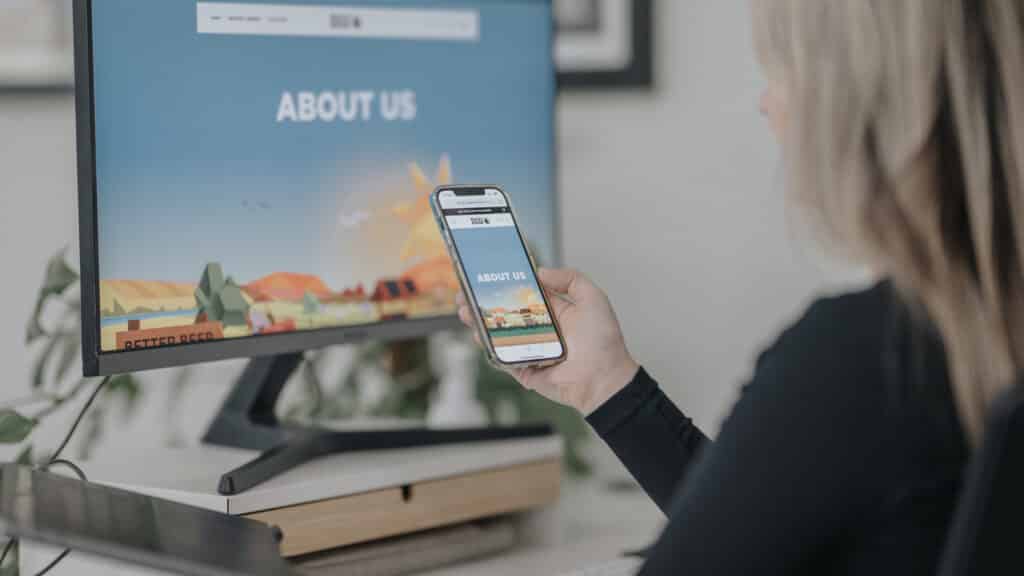Editor’s Note: This post was originally published in April 2016 and has been updated for accuracy and comprehensiveness.
What Does the Perfect Homepage Look Like?
While your homepage will contain brand elements like your logo, brand colours and personalised images, it is more often the case that business owners include things that do not bolster the image of their brand or are downright confusing or distracting.
Old school homepage design grew out of a 1950s Mad Men style marketing and sales approach. The wonderful era when salespeople had the luxury of telling their prospects that what they were offering was cheaper, faster, stronger or better. And best of all, they believed them.
Until the late noughties, homepages were typically used to blast our audience with loud, bold sales messages. Not only that, it was likely the page was SEO’d within an inch of its life with every high demand keyword we could think of. Perhaps worst of all, we felt it somehow appropriate that every single product, service, message and belief we had could be shoehorned into that one tiny page.
It was a classic “me, me, me” approach with every little to do with user experience.
Fortunately, audiences these days have grown savvy enough to see through the malarkey. They’ve learnt that talk is cheap and not to believe everything they read. Audiences now look for real evidence.
So what’s this got to do with homepage design?
The homepage is no different to any other form of digital marketing. It’s less about patronising sales talk and more about understanding who your audience is. Knowing what they’re looking for and delivering it with minimal obstacles and maximum value.
When designing a homepage there are 3 main purposes of the page;
- to captivate visitors
- to educate on benefits to the customer
- to encourage visitors to visit other pages
Typically, business owners (and many times inexperienced website designers) will do the exact opposite; they confuse the visitor, educate on features and try to give the visitor all the information on the homepage.
Here are a few ways they inadvertently do this…
WHAT NOT TO INCLUDE ON YOUR HOMEPAGE:
SKIP THE SLIDERS
Pretty much every small business owner thinks that Sliders are the “best thing since tabbed browsing”. However, sliders are a design disaster. They are distracting and they dilute the message. Sliders attempt to present the reader with something they are interested in. Moreover, they attempt to present something to the interest of “all” visitors, and sometimes to vastly different audiences, ultimately completely distracting viewers from the intended message and hurting user experience.
The Solution to Slider Frenzy:
Stop using them. Simplicity is better. Refine your marketing message to be concise but laser targeted – this is what your prospective user is looking for anyway.
FORGET HEADLINES ABOUT YOUR COOL STUFF
If most small business owners don’t fall into the slider trap above they will invariably fall for this one; headlines about their cool stuff. Simply, people are not visiting your homepage to learn how cool you think you are, they are trying to solve a problem and if you can not communicate how you solve their problems quickly, they will likely leave to find a site that will.
The Solution to Headline Haughtiness:
Write headlines that help a searcher with a specific need. Avoid writing about your company or its “stuff”.
DITCH THE NEWS
If business owners think sliders are the “best thing since tabbed browsing” then posting company news on the company homepage is a close second. No one cares about your “news”! It is not the reason why they are there. This goes back to the second point above, people don’t want to hear about “you” they want to know you are about them. Now don’t get me wrong, you can still have news articles on your website it can be interesting for your staff or important for your investors however, the homepage is not the place for it.
Given that the homepage is probably the single highest value piece of information your business has, I thought I’d share what our experience has taught us about effective homepage design:
EFFECTIVE HOMEPAGE DESIGN
EMPATHISE WITH YOUR AUDIENCE.
Understanding who you are trying to reach and what they are looking for is the essential first step in great website design. Once you’re clear on this step, you can’t spend enough time distilling your offering into a single succinct statement. If you don’t know what that statement is, engage the services of a great copywriter (or talk to us). If you’re not willing to invest in this step, perhaps ask yourself how serious you are.
Once you have this statement clear, it’s time to quickly connects with your audience.
The first impression of your homepage is everything “above-the-fold.” Here, you must strive to be clear of general clutter that distract visitors (like slider) and instead use easy-to-read text, lots of white space and clearly labelled navigation. If you’ve attracted their attention so they scroll further down – you’ve won. For now.
ANSWER THEIR QUESTIONS.
As your site visitor arrives on your homepage, their rapid fire thought process has one goal. Getting answers to their questions. How do you know what these questions are? A good place to start is to think about what questions your customers ask on the phone or in email.
Decide what these key make or break questions are and quickly answer them. This is often in the form of buttons which link to pages containing the information. However, if there’s a way of delivering the answers on the homepage, while avoiding clutter, go for it.
BUILD TRUST.
Now that you’ve answered your visitors’ immediate questions, do they trust you? Give some thought to whether – based on your website alone – visitors are likely to trust you.
Trust is gained through many factors – great brand, design, UI, copy writing and much more. However, this really should to be a given. The functional trust builders on the homepage are elements like client testimonials (with accompanying photos or logos – no one believes anonymous quotes), case study links, etc.
As I mentioned earlier, one of the big changes in marketing over the last few decades has been the audience’s move away from an inherent belief in what we have to say. Trust must be earned. If used right, your website is a powerful vehicle for building trust in your company.
KNOW THE NEXT STEP.
If you’ve followed the process, you now have a visitor who thinks you are relevant to their needs, understands what you do and trusts you. Nice one.
So what’s the next step? One thing is certain – if you’re not clear, your visitor won’t be.
It’s common to think that a strong call to action (CTA) is required on the homepage. Sometimes this might be the case, but only if your homepage process has successfully taken the user from enquiry to qualified buyer. This is rare in one single page.
More often, the purpose is to get a visitor to the next stage. This next page might be anything from your case studies, specific services or product pages. Whatever it is, be purposeful.
Clearly there is no perfect homepage design – every page will resonate differently with different people. My experience is that following these general steps will increase your conversion rate.
Combining this with careful measurement and monitoring of your Google Analytics and enquiries will put you on a path to an improved conversion rate.







